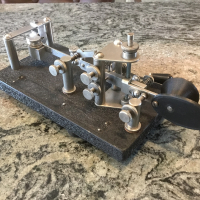Welcome to the FlexRadio Community! Please review the new Community Rules and other important new Community information on the Message Board.
Need the latest SmartSDR or 4O3A Genius Product Software?
SmartSDR v4.1.3 | SmartSDR v4.1.3 Release Notes
SmartSDR v3.10.15 | SmartSDR v3.10.15 Release Notes
The latest 4O3A Genius Product Software and Firmware
SmartSDR v4.1.3 | SmartSDR v4.1.3 Release Notes
SmartSDR v3.10.15 | SmartSDR v3.10.15 Release Notes
The latest 4O3A Genius Product Software and Firmware
If you are having a problem, please refer to the product documentation or check the Help Center for known solutions.
Need technical support from FlexRadio? It's as simple as Creating a HelpDesk ticket.
Need technical support from FlexRadio? It's as simple as Creating a HelpDesk ticket.
FlexRadio's CW Failings
Comments
-
All radios have their good and failed points. My Omni 7 is great at CW but Ssb/am send and receive failed after 2 years of light use. The rest of the radio is perfect. Apparently TT contracted with a one-off jobber in China for the ssb /am module who walked after the batch. So radios can approach perfection but not in everything. For what Flex chose to do, they’ve done an outstanding job. I’ll use them for their outstanding performance items and other radios for theirs’0
-
I'm going to jump in here just because I want to be counted as one of the very many "CW" ops. I seldom use any other mode.
I bought my 6500 and 6600 radios primarily because of their receiver performances. Outstanding. But I've been pretty vocal about the remote keying issues and I certainly agree that Flex is falling behind in bring new CW features.
I agree with Robert-WP4Y is his assessment that the Flex engineers have concentrated on features that few of us "mortals" without multi-op superstations really need. v2.4.9 still works for me and I don't really feel a need for the features added in v3.x. But I've had to do numerous work-arounds to fix the issues mentioned above that are standard on some other new radios. At some point you have to think "what's the point?"
There are more of us CW operators out there than you think... and we don't always like to use keyboards either.
Regretfully yours and feeling ignored in Wisconsin,
K9SO
2 -
I can't believe the "micro-chirp" resurfaced after lo these many years. A very long series of posts in the old TenTec reflector on that one!
73, Duane (previous Omni 6+ and Orion owner)
0 -
Shortly after this post went out, Flex did a technical survey of its owner/user based and subsequently published the results...
Survey Results
The following results help us understand where the true value is for FlexRadio owners. While we will not be able to address all of these things as quickly as we would like, this information is invaluable in helping us make well-informed decisions as to how we prioritize and allocate resources most urgently.
The survey responses said that the most important desired enhancements were to provide additional noise mitigation, as over 80% of respondents rated this with either a 4 or 5 on the scale of relative importance to them.
The second and third most important issues were pre-distortion (69.4% rated with either 4 or 5) and to resolve the DAX issues (62% rated with either 4 or 5) .
We were not surprised to see the desire to resolve the longstanding DAX issues to improve performance and stability, and work is already underway here to address this; however, the survey was very helpful in revealing the relative importance of noise mitigation and pre-distortion. We have heard these messages loud and clear and have already begun discussions on next steps to make improvements in these areas of performance.
This does not mean that we won’t devote any resources to the items that did not receive the highest response rates, as we will always look for opportunities to improve in these areas as well. FYI, below are the percentage of customers that gave a 4 or 5 rating to these other items related to SmartSDR v2 and v3 (in survey order):
Zero Beat CW - 29.3%
All Mode Squelch - 26.7%
Resolve Thumb DV dongle for D-Star - 13.9%
Integrate Rotor Control into SmartSDR - 33.4%
SmartLink sharing to allow multiple SmartLink accounts for a single radio - 24.9%
Add Maestro control function to SmartSDR for Windows - 39.1%
Voice Macros - 44.6%
Record Audio from SmartSDR for Windows to desktop file - 47.9%
Integrated antenna switch control - 45.7%
Band edge markers on panadapter - 51%
CW transmit while in SSB mode - 18.6%
Upgrade radio remotely over SmartLink - 29%
Once again we would like to thank you for your overwhelming support of FlexRadio. We will continue to work hard to advance your radio into the future.
73s,
FlexRadio Team1 -
Companies provide features few need because it is easy for them to do so. Icom 7300 has an audio scope which is useless. Flex 3.0 provides multi op (receive), I wonder how many need that.1
-
...and how many of these have been addressed?
0 -
Noise mitigation... NR, WNB and/or NB as I look at 75m this morning 1500z and S6 background, broadband - looks like white noise - not a single source. Yes, more work on noise.
CW QSK works okay in my daily use. At 25 wpm, adj AGC-T, AGC Fast, and filtering works to allow between dot/dash signals thru. Kind of tricky and kind of an art form.
0 -
Is there a master / tracking list of all the known CW issues?1 -
I have a 6500 and can clearly say that it has the best receiver I have ever operated in my 46 years in the hobby. Unfortunately, the CW deficiencies mentioned in this thread are making me give serious thought to selling the 6500 and go with the Elecraft K-4. I'll make that decision once a good friend (and avid CW operator) gets his K-4 and gives me his evaluation.
2 -
It will be interesting to see how the K-4 performs. But, Elec raft already has these CW features and performance now, so I think Flex is way behind even before the K-4 comes to market.
0 -
What are we comparing? K4 FAQ states sampling rate of 122MhZ which is somewhat disingenuous given we know nothing of sample bit rates compared to the 6600+ of 245 Mega Samples Per Second... IMO, the engine of their SDR is less than half the performance of a 2+ year old Flex and that makes it somehow better? if they want to sell an SDR, they need to start speaking the same language.0
-
This thread was not about sampling rates. The thread is about Flex CW short comings. Even the most basic Icom has better CW performance and features. So the thread is not about K-4 either, it is a long thread discussing Flex CW Failings.2
-
I agree that Flex has some work to do when it comes to quality CW and QSK operation. I have reported a couple of QSK bugs to Flex support which were addressed in 2.4.9 and 2.5.1.
I find QSK quality is marginal at best. It took lots of tweaking (AGC-T, AGC, Volume, Filters, APF, etc.) to get it to sound acceptable but I still hear that annoying reed relay clicking. I have stopped using QSK for the most part. My K3 has very good CW and QSK.
Here are my QSK settings https://community.flexradio.com/flexradio/topics/qsk-full-break-in
I really don't understand why we cant have QSK with the ATU engaged ! Flex sites performance issues due to internal antenna switching arrangement they use with the ATU. Also, Flex made decisions, again based on performance, not to use PIN diodes for all TR switching. Ok, I get that, but how much performance are we really trading for silent QSK operation with the ATU engaged ? How about a user option for QSK with ATU ?
It will be interesting to see how many hard core CW ops bail on Flex for the K4 ? I'm watching closely !
1 -
A Flex is designed for the highest performance. The relays used in a Flex will out last any pin diodes and have fewer problems according to examples research data.
0 -
To clarify, Flex uses a PIN diode in the transmit path and reed relay in the receive path. The reason is to eliminate introducing IMD products into the receiver.
The mean time between failure of a PIN diode is extremely high at around 1,000,000,000 hours at normal operating temps !
A typical small reed relay will have a failure rating in the 10's of millions of cycles which is good in most cases. However, running high speed QSK CW for many years on end might cause the reed relay to fail before it's time !
Who's going to do the math ?
0 -
1E9 hours is over 100,000 years. The relay, by comparison, might last 10s of years but could be less depending on how much voltage and current it is switching. I'd like to see Bill's research data that shows that the Flex relay "will outlast any pin diodes."
Also, while many relays are rated at 10's of millions of cycles that is often a mechanical rating and not electrical. For example, a popular 12V DC relay that I use in many products is rated at 1E8 mechanical cycles but only 1E5 electrical cycles if it is used near its contact ratings.
73,
Doug K4DSP0 -
As usual any time I make an incorrect comment I am tested on it. Thank you for pointing out my misinformation. What I remembered was the subject on the relays in the PGXL not being pin diodes. Flex mentioned several reasons for this.
Here is a comment from Tim some of you may remember when asked about the relays in the PGXL.
I did a calculation once and if the radio was doing a T/R transition once a second, 24 hours a day, 365 days a year, it would not hit the MTBF for something like 8 years or so. After that amount of time, if the relay goes, you probably need to send the radio in any way to have it recalibrated.
0 -
FT DX 5000:
"Great features for real CW enthusiasts", "CW Zero-in Feature", "CW Spot Feature", "Additional CW Capabilities: DSP APF, Separate KEY jacks on the front and rear panels, Built-in electronic keyer...Weight control,....
FTDX-5000 owner here and CW operator for 61 years. Let's not give Yaesu too much credit for understanding CW. Yes, the internal keyer has what Yaesu calls "weight control". Any good CW operator knows that weight is the ratio of a dot or dash to the space between. But, sadly that's now what Weight means to Yaesu. They think weight is the ratio of dot duration to dash duration. So, a 1 to 1 ratio means that a dot and dash are the same length. Is there anyone who thinks that's a useful weight control??? And that's why I use an external K1EL Winkeyer - a product by someone who REALLY knows CW.
0 -
I'm using several ICOMs and the audio scope is actually pretty useful when it comes to digital modes (including CW by the way). Referring to the 7300,9700 and 7851 in my case. It might be useless for you, for others it is definitely not.0
-
This must be a very dated survey since nothing about profiles even was listed on it.0
Leave a Comment
Categories
- All Categories
- 379 Community Topics
- 2.1K New Ideas
- 631 The Flea Market
- 8.3K Software
- 123 SmartSDR+
- 6.4K SmartSDR for Windows
- 184 SmartSDR for Maestro and M models
- 430 SmartSDR for Mac
- 271 SmartSDR for iOS
- 259 SmartSDR CAT
- 194 DAX
- 382 SmartSDR API
- 9.3K Radios and Accessories
- 39 Aurora
- 265 FLEX-8000 Signature Series
- 7.2K FLEX-6000 Signature Series
- 950 Maestro
- 56 FlexControl
- 866 FLEX Series (Legacy) Radios
- 925 Genius Products
- 463 Power Genius XL Amplifier
- 337 Tuner Genius XL
- 125 Antenna Genius
- 297 Shack Infrastructure
- 209 Networking
- 460 Remote Operation (SmartLink)
- 144 Contesting
- 788 Peripherals & Station Integration
- 139 Amateur Radio Interests
- 1K Third-Party Software






